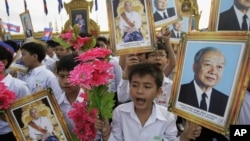BANGKOK —
Chinese state media reports that Cambodia's King Norodom Sihanouk, one of Southeast Asia's defining leaders, has died in Beijing. He was 89. King Sihanouk led Cambodia to independence, but war and his role in the murderous reign of the Khmer Rouge marred his life and times.
Flamboyant monarch, politician, film and music maker, King Norodom Sihanouk brought his ancient kingdom through independence from France, war and genocide to form a fragile democracy.
Sihanouk, born in 1922, was an only child whose parents were estranged. He was educated in Saigon and Paris, and came to the throne as a shy student of 19 in 1941.
In October 2004, in fading health, he abdicated in favor of his son, Norodom Sihamoni.
Another of Sihanouk's sons, Prince Norodom Ranariddh, spoke in 2002 of his father's artistic gifts and broad interests.
"He has made 21 movies. But not only is my father a filmmaker, but he is a great politician, even unique … and also great French cuisine amateur, great musician, composer. No one can imitate my royal father," he said.
Sihanouk quickly developed into a flamboyant, tough politician whose support came mainly from the people in the provinces. He ruled his kingdom off and on more than 60 years, and was an important symbol for his people, who witnessed one of the most tragic genocidal reigns of the 20th century.
Author and commentator on Cambodia, David Chandler says Sihanouk was a powerful link between ancient traditions and modern times.
"He brought Cambodia into the world, whereas the French had kept it cocooned and isolated for … 90 years …. But (he) was also … a figure of the old Cambodia," he said.
While Cambodia was still under French rule in 1947, he issued a constitution promising parliamentary government. Cambodia gained partial independence within the French Union in 1949, but Sihanouk campaigned for the total independence that came peacefully in November 1953.
Two years later, Sihanouk abdicated the throne to his father, while remaining head of the government. In that position, Sihanouk held a monopoly on power for the next 15 years in what became known as the "Sihanouk Era."
On the world stage, Sihanouk was a founder of the Non-Aligned Movement, which was meant to serve as ballast in the Cold War between the Sino-Soviet bloc and the West.
Sihanouk, however, failed to fend off insurrections by both communist rebels and from within his own government. During the Vietnam War, rebels backed by China and other communist governments built strength, and the North Vietnamese army also frequently crossed into Cambodia as they fought the United States. Eventually, he was overthrown.
Carl Thayer, a U.S. expert on Southeast Asia, explains. "He was overthrown when he was overseas begging Moscow and Beijing to stop their support for it (the Vietnam War)," he said.
Stripped of his power, Sihanouk fled to China in 1970 where his agitation against the new government started an internal conflict that paved the way for the genocidal rule of the Khmer Rouge.
After the Khmer Rouge swept into Phnom Penh in early 1975, Sihanouk aligned himself with the radical communists, believing it was a key to power. But by 1976, he was sidelined and fearing for his life.
The Khmer Rouge fell in early 1979, after Vietnam invaded. But Sihanouk's name was soiled by his association with the movement, which took the lives of almost two million Cambodians.
Cambodia's civil strife continued after Vietnam withdrew its troops in 1989, and in 1991, warring factions agreed to a cease-fire and signed a U.N.-backed peace agreement.
The deal enabled Sihanouk to return to Phnom Penh in 1991 from exile. He regained his throne in 1993, and became a central figure the country's political development over the past decade.
Norodom Sihanouk was one of Southeast Asia's defining leaders during some of the most turbulent years of the 20th century.





